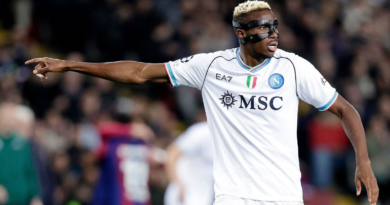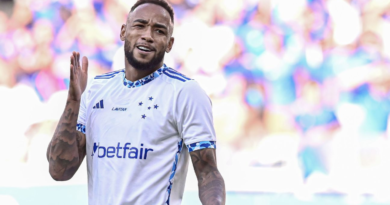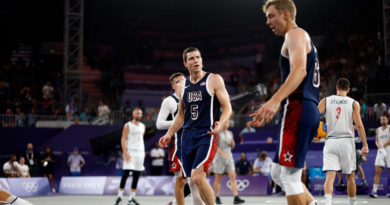What XFL owners Dany Garcia, Dwayne Johnson learned in 2023, and what's coming next
Perhaps the most notable accomplishment of the XFL’s season is it will conclude this weekend with no questions about its immediate future.
The 2001 version of the league folded within weeks after its season ended. In 2020, the league suspended play at midseason because of the COVID-19 pandemic and soon entered bankruptcy. Under new ownership in 2023, however, the XFL has played a full 40-game regular season, along with two semifinal playoff games, and will stage a championship game Saturday in San Antonio between the Arlington Renegades and D.C. Defenders (8 p.m. ET, ABC/ESPN+/ESPN Deportes).
During an interview this week with ESPN, owners Dany Garcia and Dwayne Johnson declared the season a success and began looking ahead to 2024. Garcia said the league’s front office staff will soon take an off-site retreat and many offseason staples, including a series of combines and player showcases, have already been scheduled.
Quantitative results have been mixed. As Garcia put it: “There are areas that have absolutely exceeded our expectations, and there are areas that were newly discovered.”
Games averaged 2 hours and 49 minutes — 12 minutes shorter than the NFL in 2022 and in line with the league’s hopes to produce a faster-paced event. As of midweek, 54 players had received invitations to try out at NFL camps this month.
Attendance figures, on the other hand, fell short of the COVID-shortened 2020 season. Garcia acknowledged “we have a ton of work to do.” Regardless, Johnson insisted the ownership group — which also includes Gerry Cardinale, the founder and managing partner of RedBird Capital Partners — had always planned for multiple seasons of product development.
“We’ve been doing business for quite some time, Dany and I, starting in the late ’90s,” Johnson said. “We went into this XFL season determined and committed to playing the long game. So as the numbers were coming in, they were what we expected. We didn’t expect to blow the roof off the place with incredible numbers. You want to see steady growth, you want to get feedback from the fans and the audience, you want to see how the game plays on TV and then play the long game.”
Let’s take a closer look at the XFL season and what it means for future years.
Economics
“You never know how these things are going to shake out,” Johnson said. “Especially in spring football, which has historically not worked.”
Indeed, in the 40 years after the AFL’s 1970 merger with the NFL every spring or alternative fall league has failed as a business. The current incarnation of the USFL debuted in 2022 and was the first major pro football league to return for a second season in that time span.
The 2023 XFL, Garcia said, was about “laying the groundwork.” She acknowledged the league “needed to be capitalized” after it was purchased in bankruptcy court for $15 million. Like many businesses, it would require private funding to operate at least in its initial stages.
But in terms of attendance, the league averaged 14,398 fans per game, 23% lower than during the 2020 season, amid a wide range for its eight teams. The St. Louis BattleHawks reconnected with their raucous 2020 fans to average 35,104 per game. Meanwhile two teams that were relocated from their 2020 sites — the Vegas Vipers and Orlando Guardians — each averaged less than 9,000 per game.
“Numbers always matter,” Garcia said. “Every number. But they came exactly where we were feeling and what would make sense.”
Storytelling
Attendance reflects a portion of any league’s financial health, but on several occasions Garcia and Johnson emphasized the value they see in storytelling as a critical part of the business. To that end, they leaned into Johnson’s personal history as a college football player who never made an NFL roster. They branded the theme “Player 54,” based on the NFL’s 53-man roster limit, and produced a docuseries under that title that streams on Hulu.
“We knew we were going to have the space and the time and the bandwidth to make the best decisions to build a league,” Garcia said. “We weren’t just building for a TV property. You have to lay the infrastructure.
“It’s not just the sport of the game, but we had to take charge and cultivate everything that surrounds the game. Because that is not only what our players want to experience but that is what our fans and partners demand. It’s no longer just a linear relationship. It’s what is the content? How does the content feel? What are you creating? What is the branding? What is the partnership? What is the real innovation?
“And I absolutely do think that today’s consumer, fan, audience wants to know that you’re doing good for your teammates, for our athletes, for the sport. … That to me is absolutely one of the parts of longevity, in addition to this doubling down and making the strategic move that says we will storytell, and we will make relationships and we will keep the story going to make sure that you understand the full emotional scope that goes into the game.”
The league also leaned into St. Louis quarterback A.J. McCarron after his passionate reaction to a Week 1 comeback victory, triggered by his children joining him in a postgame interview. The moment “really epitomized our narrative,” Johnson said, reflecting the emotion felt by players who are on the outer periphery of the NFL.
AJ McCarron was emotional after celebrating the @XFLBattlehawks‘ comeback win with his kids
@10AJMcCarron | @XFL2023 pic.twitter.com/6NJ9lViJvc
— ESPN (@espn) February 19, 2023
McCarron followed that path in Week 2 after another comeback victory, saying he hoped his kids would one day appreciate “watching Daddy never give up.”
“Ever since I came out of college,” McCarron added, “I’ve been kind of counted out a little bit.”
NFL connection
Although the XFL has made clear it does not envision itself as an NFL developmental league, Johnson spoke openly and extensively about the NFL this week. He said he first broached the “Player 54” idea during a 2021 meeting with NFL commissioner Roger Goodell and other league executives and views the theme as “one of our grounding, anchoring elements of the XFL.”
Johnson called it “my personal hope and wish” that “players felt seen, and they felt they had a real shot to play beyond this season, whether it was in the spring or play in the fall [in the NFL].”
A path to the NFL was also a major selling point to players and agents deciding whether to play in the XFL or USFL. The XFL season’s February-May timeframe dovetails with the start of NFL offseason programs, in theory giving players a chance to make an impression before training camp rosters are built. USFL players wouldn’t be available until the end of June or early July. To that end, the XFL has heavily promoted the players who have received invitations to try out at NFL rookie camps this month. Per XFL rules, those players can begin signing NFL contracts next week.
The XFL also reached a collaboration agreement with the NFL to share the results of its rulebook innovations as well as to serve as a developmental ground for on-field officials. Three officials who worked XFL games this season, on loan from the NFL’s Mackie Development Program, have been hired to work NFL games this fall. One is Jeff Bilbo, whom Garcia said approached her during a timeout to say that he believed the XFL had been his ticket to the NFL.
Hub model
The XFL is likely to maintain its in-season model of practicing at a central location — in 2023, that was in and around Arlington, Texas — while playing games in local markets.
“To me it has always been very important,” Johnson said, “that if we’re calling ourselves the St. Louis BattleHawks, we’re going to be in St. Louis and we’re not going to go to Virginia or some other state to play.”
The league is considering the possibility of hosting winter minicamps in home cities to jump-start the connection between teams and fans. But a shift to an all-local structure isn’t on the immediate horizon.
“It’s an evolving answer,” Garcia said. “One of the most important things that we had to have is a certain level of quality of care, play and oversight with our athlete. We didn’t want any discrepancies, so the hub helps us tremendously. And because of our strong content weight and the amount that we do, the hub allows us to be on that 24-7. So it was super valuable.
“Then as the league continues to grow and when we get to a point where we can duplicate the excellence that’s within our Arlington hub, that would be [when we face] a decision.”




